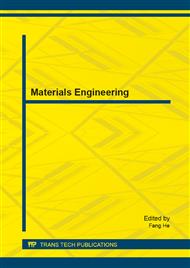[1]
N. Booth, A. S. Smith , Goodwin House Publishers, New York & Boston, Vol. (1997),P. 241-248.
Google Scholar
[2]
L.L. Chen, Z.H. Xiong, 10. 1109/SOPO. 2011. 5780493, IEEE Xplore Digital Library (2011).
Google Scholar
[3]
Z.H. Xiong, L.L. Chen, Q.X. Wan, Advanced Materials Research Vol. 295-297 (2011),P. 1322-1325.
Google Scholar
[4]
J . Hu, R.G. J. Gordon, Appl. Phys. Vol. 71 (1992),P. 880.
Google Scholar
[5]
R. Deng, X.T. Zhang, J. Lumin. Vol. 128 (2008),P. 1442.
Google Scholar
[6]
M. Ajili, M. Castagne, Najoua Kamoun Turki, Superlattices and Microstructures, Vol. 53 (2013),P. 213-222.
Google Scholar
[7]
S. Ilican, M. Caglar, Y. Caglar. Applied Surface Science. Vol. 256 (2010) ,P. 7204-7210.
DOI: 10.1016/j.apsusc.2010.05.052
Google Scholar
[8]
H. Benelmadjat, B. Boudine, O. Halimi, and M. Sebais, Optics & Laser Technology. Vol. 41(2009),P. 630-633.
DOI: 10.1016/j.optlastec.2008.09.011
Google Scholar
[9]
S. Aksoy, Y. Caglar, S. Ilican, et al., Optica Applicata, Vol. XL(1)(2010).
Google Scholar
[10]
M. Vishwas, K. Narasimha Rao, K.V. Arjuna Gowda, R.P.S. Chakradhar, Spectrochiica Acta Part A: Molecular and Biomolecular Spectroscopy, Vol. 95 (2012),P. 423-426.
DOI: 10.1016/j.saa.2012.04.006
Google Scholar
[11]
Y.N. Wu, M. Xu, C.J. Dong, et al., Acta Phys. Sin., Vol. 60 (7) (2011),P. 077505.
Google Scholar
[12]
M. Jung, S. Kim, S. Ju, Optical Materials, Vol. 33 (2011),P. 280-283.
Google Scholar
[13]
G. Kresse, and J. Hafner, Phys. Rev. Vol. B47 (1994),P. 558.
Google Scholar
[14]
G. Kresse, and J. Furthermuller, Phys. Rev. Vol. B 54 (1996),P. 11169.
Google Scholar
[15]
W. Z. Xu, Z. Z. Ye, T. Zhou, B. H. Zhao, and J. Y. Huang, et al., J. Cryst. Growth. 265 (2004) 133.
Google Scholar
[16]
Y.N. Xu, W. Y. Ching, Phys. Rev. B. Vol. 48 (1993),P. 4335-4351.
Google Scholar
[17]
V. Shelke, B.K. Sonawane, M.P. Bhole, and D.S. Patil, Journal of Materials Science : Materials in Electronics, Vol. 23(2) (2012),P. 451-456.
Google Scholar
[18]
C.J. Huang, M.C. Chiu, H.C. Yao, et al., J. Electrochem. Soc. Vol. 155(12) (2008),P. K211-K218.
Google Scholar
[19]
Z.H. Xiong, L.L. Chen, C.Q. He, and Z.J. Liang, Journal of Physics: Conference Series Vol. 276 (2011),P. 012194.
Google Scholar
[20]
S.Y. Bae, C.W. Na, J.H. Kang, and J. J. Park. Phys, Chem B. Vol. 109(7) (2005),P. 2526-31.
Google Scholar
[21]
L.J. Li, K. Yu, Y. Wang, and Z.Q. Zhu, Applied Surface Science, Vol. 256(11) (2011),P. 3361-3364.
Google Scholar


